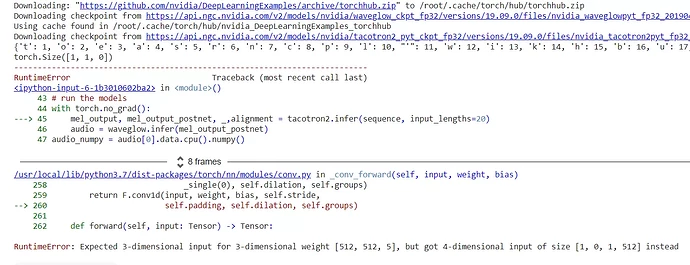I have tried multiple approaches but unable to resolve this issue. I have trained my TTS model but after running the inference code I’m facing this issue. I have done implementing reshape and unsqueeze method but nothing worked. The model is a trained tacotron2 model for generating audio samples. However my input size is already of 3 dimension as shown in the ss attached. Please help me resolve
this!!!
(embedding): Embedding(148, 512)
(encoder): Encoder(
(convolutions): ModuleList(
(0): Sequential(
(0): ConvNorm(
(conv): Conv1d(512, 512, kernel_size=(5,), stride=(1,), padding=(2,))
)
(1): BatchNorm1d(512, eps=1e-05, momentum=0.1, affine=True, track_running_stats=True)
)
(1): Sequential(
(0): ConvNorm(
(conv): Conv1d(512, 512, kernel_size=(5,), stride=(1,), padding=(2,))
)
(1): BatchNorm1d(512, eps=1e-05, momentum=0.1, affine=True, track_running_stats=True)
)
(2): Sequential(
(0): ConvNorm(
(conv): Conv1d(512, 512, kernel_size=(5,), stride=(1,), padding=(2,))
)
(1): BatchNorm1d(512, eps=1e-05, momentum=0.1, affine=True, track_running_stats=True)
)
)
(lstm): LSTM(512, 256, batch_first=True, bidirectional=True)
Actual Code:
waveglow_path =
torch.hub.load('nvidia/DeepLearningExamples:torchhub',
'nvidia_waveglow')
#waveglow = torch.load(waveglow_path,
map_location=torch.device("cpu")) # waveglow_pt is the path to the
.pth file
#waveglow = torch.load(waveglow_path)
waveglow = waveglow_path.to('cuda')
waveglow.eval()
#waveglow.cpu().eval()
tacotron2 = torch.hub.load('nvidia/DeepLearningExamples:torchhub',
'nvidia_tacotron2')
model_path = '/content/TTS_Nigerian'
#tacotron2 = torch.load(model_path,
map_location=torch.device("cpu"))
#tacotron2 = torch.load(model_path)
tacotron2.load_state_dict(torch.load(model_path)['state_dict'])
print(tacotron2.state_dict)
tacotron2 = tacotron2.to('cuda')
tacotron2.eval()
tk = Tokenizer()
text = "Now please click on the start button or say 'start' to
proceed"
tk.fit_on_texts(text)
sequence = np.array(tk.texts_to_sequences([text]))[None, :]
#sequence = sequence.astype(int)
sequence = torch.from_numpy(sequence).to(device='cuda', dtype =
torch.int64)
print(sequence.shape)
torch.squeeze(sequence,[1,3])
with torch.no_grad():
mel_output, mel_output_postnet, _,alignment = tacotron2.infer(sequence, input_lengths=20)
audio = waveglow.infer(mel_output_postnet)
audio_numpy = audio[0].data.cpu().numpy()
sampling_rate = 22050
write("audio.wav", sampling_rate, audio_numpy)
from IPython.display import Audio
Audio(audio_numpy, rate=sampling_rate)
